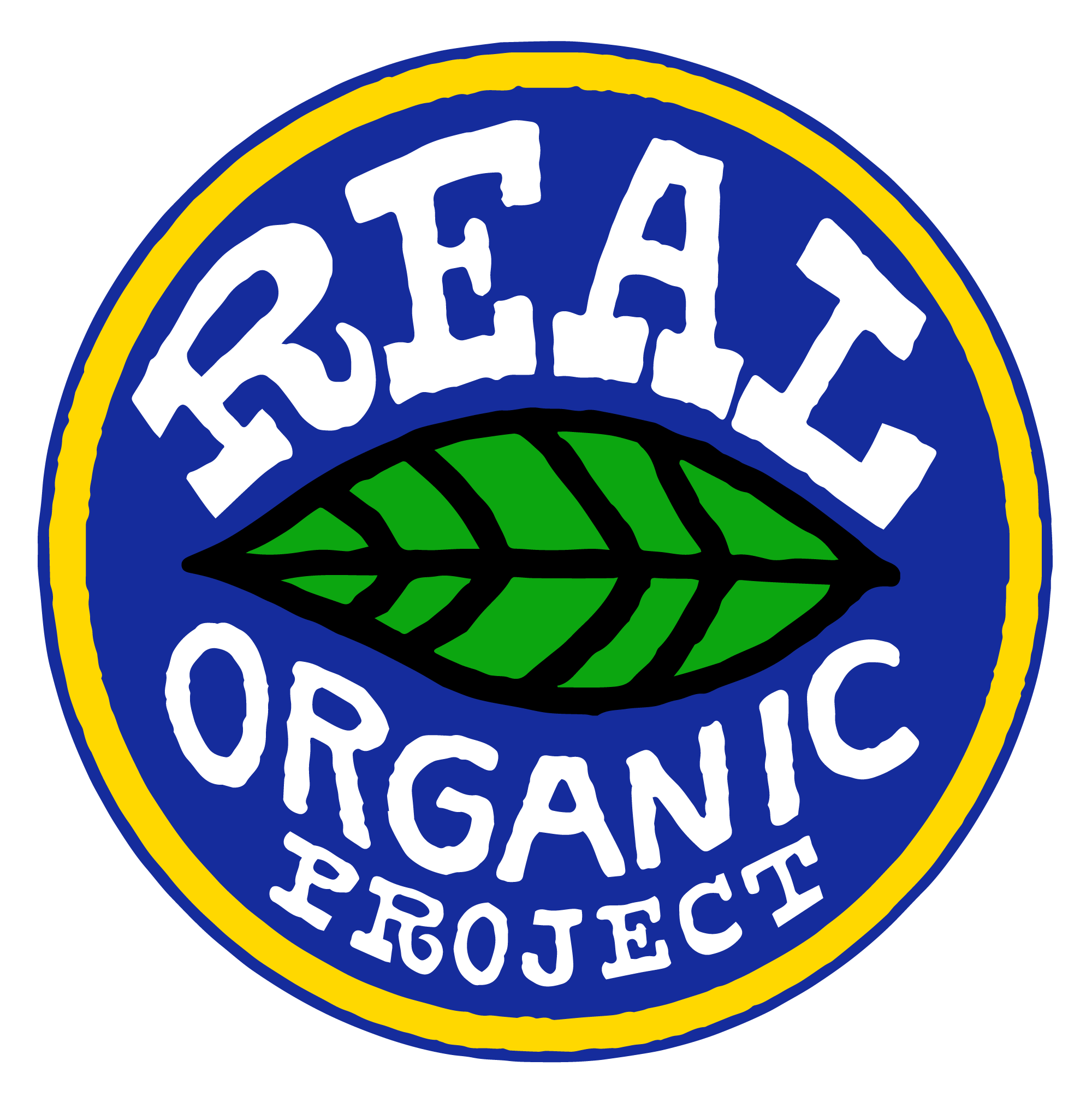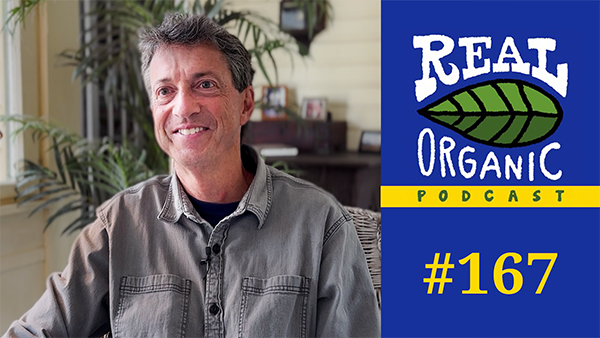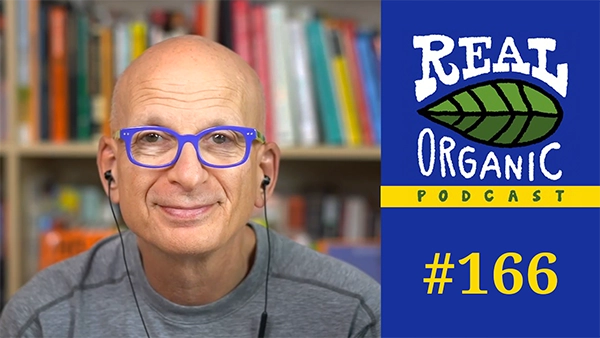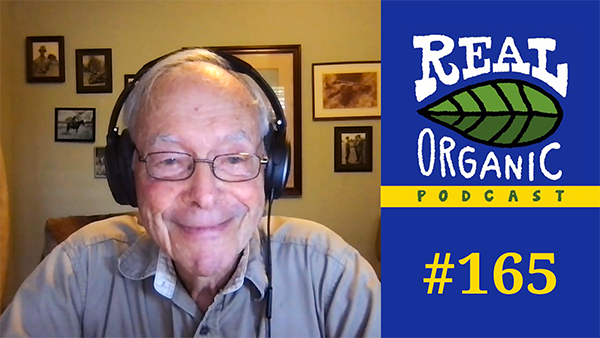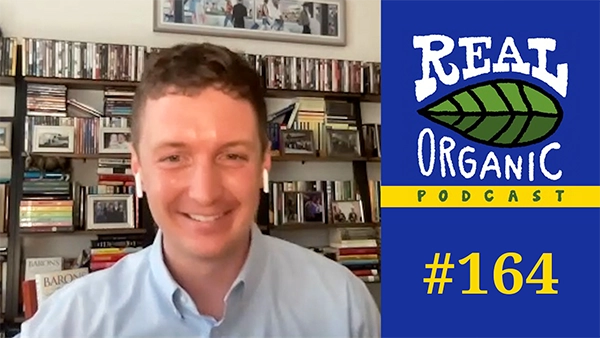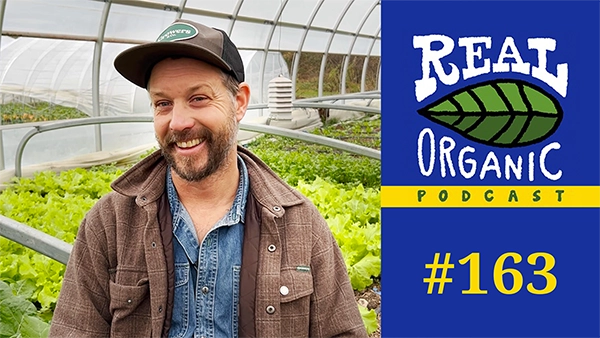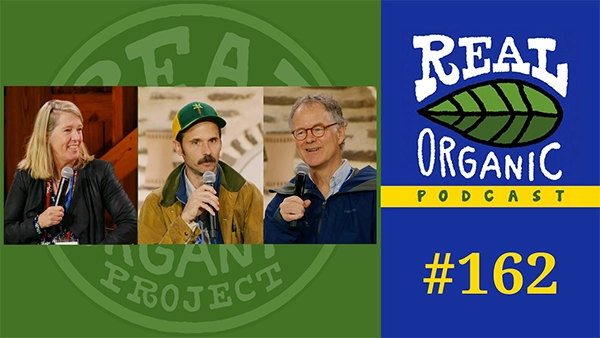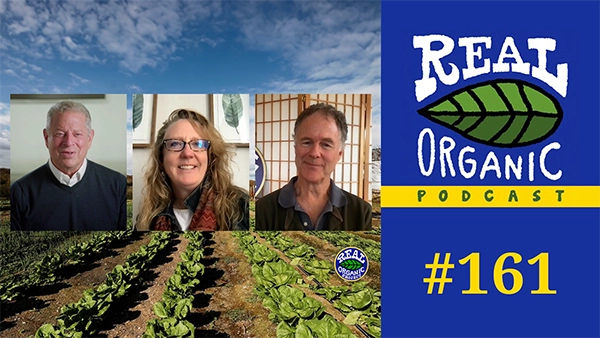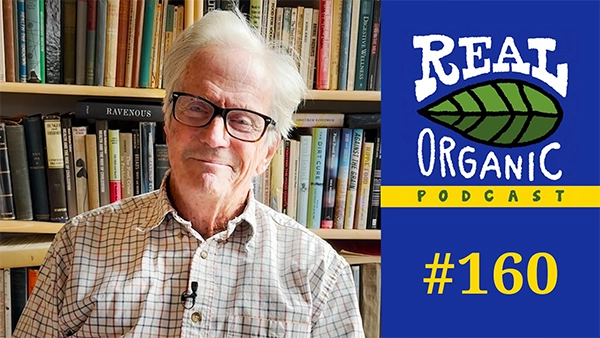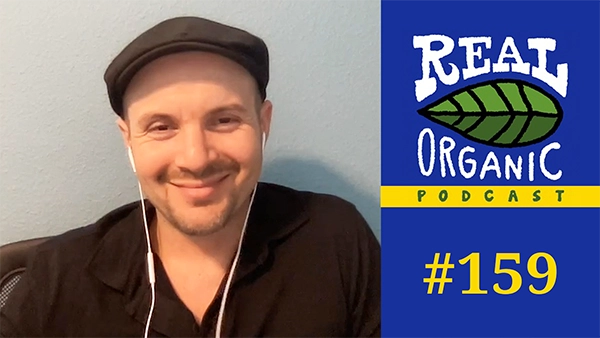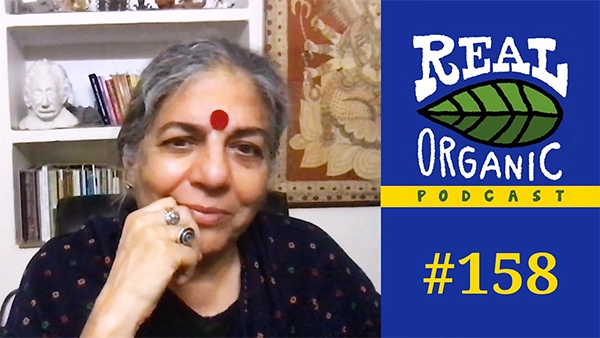Episode #067
Anna Jones-Crabtree: Our Organic Supply Chain
Needs A Makeover
Welcome! You can subscribe and download episodes of our show through your favorite podcast app.
You can also subscribe to receive the video version of each episode on our YouTube channel.
Our Anna Jones-Crabtree interview has been edited and condensed for clarity.
Anna Jones-Crabtree (00:00:00):
I farm because, because it’s like a responsibility it’s like, I wanna do more with our conservation. I wanna be an agent of change. And I feel like if I want sustainability on the planet, this is a way that I can physically manifest that and show that to others and help others learn and maybe model some new ways. Like we don’t have it figured out. You know, the land that we’re farming way north on the border. We’re on the very far Western edge of Prairie pothole migratory bird habitat. And I’m so excited about some of this transition ground that we just took in because now we’re gonna have some more contiguous management of organic and I’m really excited to find other partners in conservation to say, what does that look like? How do we do agriculture integrated with nature? It’s not like we’re just setting it aside and we’re gonna do agriculture over here and nature over here. Like she’s part of it.
Linley Dixon (00:01:10):
Welcome to the Real Organic Podcast. I’m Linley Dixon, co-director of the Real Organic Project. We’re a grassroots farmer-led movement with an ad-on organic food label to distinguish crops grown in healthy soils and organic livestock raised on pasture. You just heard from Anna Crabtree of Vilicus farm, a dryland grain farm in Northern Montana, they focus on biodiversity in the fields and an overall diversity in their income streams. I interviewed Anna and her husband Doug last summer and was really struck by their thoughts on how both farm subsidies and crop insurance affect their operation in a negative way. I’m so thrilled today to be speaking with Anna Jones, Crabtree of Vilicus farms in north central Montana. Hi Anna.
Anna Jones-Crabtree (00:01:55):
Hi Linley. How are you?
Linley Dixon (00:01:57):
Good. I was checking out where your farm is and you’re all the way up next to the Canadian border. What, how did you end up there and what is it like farming? So far north?
Anna Jones-Crabtree (00:02:06):
Well, it’s kind of funny. You think you’re north and then you realize there’s an entire nation north
Anna Jones-Crabtree (00:03:00):
Because Doug had been serving as the organic certification program manager for the state of Montana. So our network was here and thought, why not land is available? And that’s how we ended up here. And we started with 1,280 acres in 2009 that we bought off the open market. And this season we are managing 12,600 acres. We had no idea land available availability was gonna be so great for us. And partly why we’ve scaled up is we’ve been taking on more acres to transition. So this year there was about 3000 acres that we’ve started the transition into organic production. We have a seven year crop rotation across most of the farm. There’s a component of small grains. There’s a component of legumes which tend to be lentils or peas and then a component of broad leaves and oil seeds, which are like flax and buck wheat and interspersed in between all of those is a year of cover cropping. So
Linley Dixon (00:04:00):
Wait, you didn’t mention corn or soybeans what’s the
Anna Jones-Crabtree (00:04:03):
Matter with you? No, no, they don’t. We don’t grow them here.
Linley Dixon (00:04:53):
Anna Jones-Crabtree (00:04:59):
Well, that was all Doug. So about 26% of our acres is in non crop conservation. So that includes our pollinator strips. We’ve extensive field buffers. You know, Doug did a lot of inspecting of other organic farms and just really diversity is something that really hit home for him. And that that’s been key. And so, you know, across the landscape, then we can manage that diversity, both like spatially and temporally at a larger scale across the landscape, the field, the buffers. We knew we were farming in a place that could be prone to wind erosion and highly variable conditions. And so the, the original buffers between each of the crop strips were for soil erosion protection, because we have to, you just catch
Linley Dixon (00:05:51):
Your own soil if it blows. Huh?
Anna Jones-Crabtree (00:05:53):
Yeah. It’s, it’s terrifying when that happens. And the so because tillage is part of our system and then gradually over time we’ve realized that those field buffers really have this multiple stacking of benefits. So it’s not just about soil erosion. It’s like, oh wow, that’s a way to add more diversity into your farm with perennial habitat for pollinator species. It provides snow catch in the winter. So we can see in our combine, the yields right on the west side of every one of those strips, cuz it’s caught snow. Well, you wouldn’t think so. There’s more
Linley Dixon (00:06:25):
Moisture in the
Anna Jones-Crabtree (00:06:26):
Soil. Yeah. There’s more moisture in the soil. So anyway, and it’s a great way to access all of our fields and see them. And as we do soil testing, et cetera,
Linley Dixon (00:06:38):
Could you explain a little bit more about what follows, what, and you talk about tillage and needing to till, and I know there’s so much confusion around the sustainability of tillage. Could you maybe just talk about your system and how you feel it’s sustainable because obviously that’s important to you through the, you know, background that you all have in organic.
Anna Jones-Crabtree (00:06:56):
Yeah. I can certainly do that. This is really a good platform for Doug to do that. Great, I’ll ask him the same question. Ask him the same question I will. Yeah. Because he’s, you know, I’m the engineer and he’s the agronomist. So he’s, he’s gonna talk more about the crop rotation because he’s really the brains behind that. Okay. and it gets tweaked every year, depending on what happens. So generally there’s like a light feeding grain, there’s heavy feeding grains, and then there’s cover cropping, which can be a single crop of chickling vetch. Or it could be a multi-species cover crop depending on what that strip needs and the soils and et cetera. And then after that well, and I’m not gonna have these in the right order Linley. So
Anna Jones-Crabtree (00:07:51):
Although sometimes that can be another crop that’s for non harvest. And then the broad leaves tend to be oil seeds or buck wheat. And then there’s also another thing we’ve been adding around peas and oats. So oats are a lighter feeding grain and they take less from the soil. So and then the other thing that we’ve added over the last two years is we have a young gentleman working with us. Who’s started a grazing enterprise. So we’re actually bringing other people’s cows to the farm. Paul’s managing them and they’re eating our cover crops. So instead of us terminating those, let’s say a blade plow or a tillage pass. We’ve been experimenting with the cows doing it.
Linley Dixon (00:08:38):
Would you talk a little bit about why so much of grain farming is corn and soy and how you’ve been able to make it work financially to do all these other crops?
Anna Jones-Crabtree (00:08:51):
I don’t know, corn and soy, it’s more of a Midwest thing like in Montana, it’s basically wheat. Is it? We’re in a, we’re in a place where it’s wheat or not wheat.
Linley Dixon (00:09:01):
Okay, thank you. Yeah, just because you said it’s dryer.
Anna Jones-Crabtree (00:09:03):
Huh? It’s drier. And traditionally it’s been wheat and then fallow and what’s been happening is people have been moving away from black fallow, which is a tillage pass. So you’ll in our ecosystem. The tradition is to seed a crop one year and then the next year seed nothing. So in instead of a black fallow tillage pass, which had been traditionally done now they’re just leaving the residue from the previous grain crop and spraying. So there’s a, so that, so it’s basically a chemical fallow instead of other kind of fallow. So that’s is
Linley Dixon (00:09:46):
This so that they can no-till so they’re herbiciding it down and then they drill in the next crop.
Anna Jones-Crabtree (00:09:51):
Yeah. Okay. So it’s basically, they’re basically substituting herbicides
Linley Dixon (00:09:57):
For
Anna Jones-Crabtree (00:09:57):
Tillage, for tillage and on our farm we have, I think six different tillage tools. So it’s not like it’s the same tillage tool all for the same thing you have to really think about. When do you use tillage? What’s your reason for using tillage? Which tool do you use given the conditions that you have? I mean, a, a disc is really different than a blade plow. Like a blade plow is something it’s an undercut or giant V blades that just slice off terminate our cover crops because it’s about soil moisture management in our ecosystem. So we always wanna terminate those cover crops before they go to flower. So they’ve added the nitrogen and the benefits to the soil. And then the beauty of this year is we terminated them and everything just laid down on top of the soil, left all the biomas there and the soil covered. So it’s really more of an art of really understanding what tool you use when and for what purpose you know, nature has disturbance in it. So, you know, think about what what’s the reason for the disturbance. Well, you can’t, you gotta feed something back to the soil and the way to do that is to incorporate the residue.
Linley Dixon (00:11:09):
See, I haven’t heard about the, the blade that you’re talking about. I’ve just heard about the roller crimper. So could you talk a little that, so for termination, that’s how you do it. It’s the, the kind of undercut
Anna Jones-Crabtree (00:11:19):
With the blade. We use an undercut or we use a speed tiller which is, you know, not very deep, less than two inches terminates the crop inter mixes it in with that top layer of soil. So there’s some protection, but then also, so the microbes can, can eat away and it can go back into the soil. The roller crimper, again, this is part of the challenge is there’s not a one size fits all. You have to think about your ecosystem and for us you have to have something that has enough moisture in it to actually crimp
Linley Dixon (00:12:01):
Anna Jones-Crabtree (00:12:15):
That has not been an issue, an issue for us, the cooler soil issue. And in fact, actually it’s great because you can terminate, like we did that with our chickling vetch this year and the blade plow and it lays there on top. And when we had, you know, a hundred degree temperatures in July, that’s actually a really positive thing for
Linley Dixon (00:12:36):
Us. Yeah. You’re holding onto water.
Anna Jones-Crabtree (00:12:38):
Yeah. You’re holding onto water. You’re keeping cooler temp, your soils coolers, your microbes are happier.
Linley Dixon (00:12:46):
Have you been following any of the policies that are, are giving a lot of these climate carbon credits to no-till with herbicides? Oh
Anna Jones-Crabtree (00:12:55):
And
Linley Dixon (00:12:56):
You know, how, how should organic farmers really be standing up? I’m sure. I imagine you’ve been maintaining soil organic matter for decades. And so, you know, how do you show kind of that maintenance over the, you know, farmers that have been degrading, their soils that are now going to increase and get these carbon credits? What are
Anna Jones-Crabtree (00:13:13):
You concerns you have for that? That’s, that’s a trick. So I can’t say I’ve done all of the climate policy stuff, because there’s so much happening right now to follow it. But I, I think it’s a good thing to be having the conversation. I think you know, for a farm like ours, I’ve been trying for years to say, where can we get payments for ecosystem services? Because in a year like this, where we had terrible drought, we had the best looking crops we’ve ever had early June. Doug was doing crop scouting and we were giving things eights on a scale of one to 10, which we’ve never done. And by the end of June, early July, we were giving things three. We literally watched the, the lentils just desiccate away because it became 90 degrees plus no moisture, 50 mile an hour winds, it was miserable.
Anna Jones-Crabtree (00:14:08):
So in a year like this, those ecosystem services payments, we still planted all the cover crop. We still did the things to take care of our soil. And the only way we have income is if we have a crop to sell. So, so the ecosystem service payments are a way to, I think, help make up that difference, make that recognition of farms that are actually doing the right thing. However, the way that I’m seeing them be implemented is not necessarily gonna be conducive for organic farmers. We worked with one of the carbon markets early on and were told that we’re too complex to model. So, so that
Linley Dixon (00:14:52):
Great.
Anna Jones-Crabtree (00:14:52):
So they dropped us. Right. So, and you know, that thing is, we’ve been doing this. It has, there’s this issue of additionality, right? You have to adopt a new practice or a new thing. And this has been part of our farming system since 2009. So there’s no credit for the work that we’ve already done investment of the long, the long haul. So
Linley Dixon (00:15:12):
And continue to
Anna Jones-Crabtree (00:15:13):
Do and continue to do. Yeah. I mean this year is the prime example. We took on another 3000 acres
Linley Dixon (00:15:28):
You know, there are, let’s talk a little bit about what your concerns are with herbicides, because this is becoming such a big thing. Now no-till with herbicides what are kind of those farmers missing out on when they use them, what’s happening to their soils? Where are your concerns? Mm.
Anna Jones-Crabtree (00:15:44):
You know, a great questions Linley, and I don’t know that I’m gonna be the best person to talk about that because I don’t even pay attention to the herbicides. So, you know, that’s just not anything that we use in our system. We’re just not gonna use a method of killing. That’s just not part of us. I, I will tell you though that, you know, for us the take, for example, the acreage we just took on this year new landowner, great lease were transitioning. The farm previously had been just wheat wheat, no wheat wheat, no wheat. Okay. So we, we wanted to do peas. We had a contract for non-GMO Peas because that transition period’s really tough. Right? You’re not getting organic prices and you’re trying to move your soil to a healthier state. So your production might be different. And then we found out what herbicide had been sprayed and it’s something that sticks around in the soil for 36 months and decimate anything, broadleaves. So there was absolutely no way that we could plant the peas then. So we have which herbicide
Linley Dixon (00:16:49):
Was it?
Anna Jones-Crabtree (00:16:50):
Oh, I’m trying to remember the name they all
Linley Dixon (00:16:52):
Have. Was it Aminopyralid?
Anna Jones-Crabtree (00:16:54):
I don’t know. It was some other, I don’t remember all the names there’s
Linley Dixon (00:16:58):
I know there’s newer chemistries that are actually fat soluble that kind of mimic hormones. So really small doses are effective. So they got the highest, like the best ratings from the EPA. But the reality is that those small doses mean they’re effect, you know, first of all, they’re fat soluble. Yeah. So they’re not gonna wash away and they’re effect lasts for years. Right. And in dry climates it’s even worse. Well,
Anna Jones-Crabtree (00:17:22):
Right. Cause you don’t have the moisture movement. Yeah.
Linley Dixon (00:17:25):
Right. The, the, the life and the soil can’t really break it down if it’s so dry. So we’ve, we’ve had, you know, we farm in a plot that it’s, it’s been 10 years since it’s sprayed and we still, they, it was spot sprayed, but we still see the places where those aminopyralids were, were sprayed. I think milestone is the common name for milestone, you know, what’s, what’s used a lot. And that’s the aminopyralid chemistry, but there’s others out
Anna Jones-Crabtree (00:17:51):
There too. Yeah. I don’t know. This might have been ally or the names are all just so fascinating to me. It’s like we’re at war. Right, right.
Linley Dixon (00:18:22):
It was the legumes that reacted the most. It must be that same chemistry. Is that, is that what you’re saying?
Anna Jones-Crabtree (00:18:26):
I know,
Linley Dixon (00:18:27):
I know legumes are very sensitive to them.
Anna Jones-Crabtree (00:18:30):
Legumes, broadleaves. Like we couldn’t pivot and do flax or anything else like that because it’s, you know, it was 36 months that it can hang out in the soil
Linley Dixon (00:18:39):
We actually had, well, they say 36 months and it turns out to be like a decade. It
Anna Jones-Crabtree (00:18:44):
Can be more like it’s worse. I mean, it can be more like
Linley Dixon (00:18:46):
Right, depending on the rain and right. You know, if, if you get some tillage in there, that’ll probably speed it up. But especially if you have moisture, but we brought in Dow is the one that produced the particular one that we’re struggling with. And we brought in a representative and she said, you know, it’s on you to test your soils and your compost. And if you get this bioassay so these plants don’t react and these plants do and Peas was one of the ones that react all the legumes do. You know, and the cucurbits don’t then you know that you’ve got herbicide carryover and it’s up to you to plant accordingly. And it’s like, well I I’m a tomato farmer. Right, right. You need to get tomatoes in the ground and then they’re sensitive. And so how is this on me? I wanted to be like, you shouldn’t be producing a product that lasts for decades in the soil, in an aired climate, you know? Yeah. That was the response I got.
Anna Jones-Crabtree (00:19:34):
Oh, that’s too bad. I know like what Do we do of there’s, you know, in Montana alone, there’s 18 million acres of crop land and less than 1% of that is certified organic. So, and we’ve got a long way to go if we actually wanna scale up and have more acres under what Doug and I believe is a more sane production system that doesn’t use those off-far inputs. And the chemicals that just stick around for a very long time. So
Linley Dixon (00:20:05):
Let’s talk about that. There’s only 1% in Montana and that’s kind of the trend across
Anna Jones-Crabtree (00:20:10):
The country in generally. Yeah. I haven’t checked recently, but it was about 1%. Yeah.
Linley Dixon (00:20:15):
So I’ve heard you say it’s just hard work and that’s why there’s not more organic acres, but what are all the things that are contributing to kind of the reasons why there isn’t more?
Anna Jones-Crabtree (00:20:25):
Oh, well the other thing Doug and I are doing is we have an apprentice program. So we’ve been bringing in young individuals to be part of our operation with the idea that if we are, are mutually agreeable, we can then help them incubate an enterprise or incubate into managing one of our farm units and do that collectively together.
Linley Dixon (00:20:49):
So all that. So you’d say it’s skills. That’s
Anna Jones-Crabtree (00:20:51):
A big one. Also that to say is I think it’s skills. I think it’s a mindset. Like we think it’s gonna be easier to bring people with an organic mindset or bent to agriculture than trying to
Linley Dixon (00:22:00):
I was talking with Amanda Starbuck with, at food and water watch. And she was talking about the reason why she does her work is because her mom left farming from North Dakota because she just, it, it seemed like an awful way of life. And so is it possible that what you’re doing when you’re using that thing between your two ears, you know, is a little bit more fun and interesting and like, oh we like a lot of people might wanna do it actually instead of, you know, the chemical farming. Yeah. That just where you’re sitting on a tractor all day.
Anna Jones-Crabtree (00:22:29):
Yeah. I mean, we, we think so, but you know, I, let’s not gloss over. It’s not all roses and glory and unicorns and rainbows, right? Like there is a lot of talk about regenerative agriculture. There’s supposedly a lot of money going into regenerative agriculture. I think the biggest thing we gotta get out of the mindset on is it’s not gonna be one silver bullet. It’s not gonna be one magic, fun. It’s every single farm like ours needs some stability and some stable income cuz in a year like this, what is our backdrop? I don’t what’s our backdrop. Our backdrop is crop insurance, which is not that fabulous for a farm like ours. It’s super diverse or Doug and I go get another disaster loan that is personally, we personally hold from USDA. So I think the gap between this discussion and talk about what kind of agriculture we all wanna see in the morning.
Anna Jones-Crabtree (00:23:27):
And then, then what it takes to actually do it on the ground. Like we need more people doing it and we need every single farm organism. That’s doing it now to be in a place that’s stable to keep doing that soil building cuz soil building doesn’t happen on quarterly profit reporting cycles and, and the other system. It’s not that it’s just easier. It’s not that those people are not smart doing it. It’s that you’re stuck in a system that you can’t, you can’t even fathom how you’re gonna get out of it. Right? So like, oh, well maybe I stop using some herbicides that might save me some money, but then I got this weed problem. I don’t know how to handle. And then, oh man, that messes up my crop insurance, which is my backstop. I mean crop insurance today, you can ensure 80% of your revenue, what business can’t make.
Anna Jones-Crabtree (00:24:19):
It ensuring 80% of your revenue. I mean the most that we can ensure because we’re on whole farm and we’re trying to do diversity is maybe 60%. So there needs to be some other support mechanism to make up that gap in years like this. So, you know, frankly climate change, it’s terrifying. It’s terrifying to think about the variability. We’ve seen such variability and it’s, we know we’re farming in a challenging place. We know that it’s variable to start with, but it is more variable than it has ever been. And you can’t, you can’t count on anything and it’s it is, it’s hard. Like it’s mentally hard to watch this lentil crop. That’s amazing. Just go to nothing like
Linley Dixon (00:25:10):
The work. Yeah. You don’t have that irrigation water to, you know, rely on like everybody does.
Anna Jones-Crabtree (00:25:14):
Right. Well in irrigation, is there
Linley Dixon (00:25:16):
Irrigation in your area or is everybody dry farming?
Anna Jones-Crabtree (00:25:18):
No, we’re dry farming. It’s all dry. Okay. You know, and I think we gotta think about irrigation too, right? Like it’s not just about the carbon cycle on the planet. It’s about the water cycle on the planet and that is gonna be as confused and variable
Linley Dixon (00:25:42):
Yeah. Part of, I mean there’s so much there in what you just said, so I don’t even know where to go because
Anna Jones-Crabtree (00:25:45):
It’s yeah, I know. Sorry.
Linley Dixon (00:25:47):
No, it’s so good
Anna Jones-Crabtree (00:25:48):
Heavy duty stuff.
Linley Dixon (00:25:49):
Anna Jones-Crabtree (00:26:10):
Well, this is what’s confusing is we can actually insure just the wheat that way, which we’re doing, but the rest of the farm were not. I mean, how do you, and, and part of that is because it’s a system we’re trying to insure a system of production, not an individual crop. So we need to be incentivizing the systems, the holistic systems within integrated approach. And that’s the theory behind whole farm. The implementation has been less than satisfactory for us because the agents don’t know how to use it. RMA doesn’t know how to use it. The adjusters don’t know how to use it. It’s super confusing when you’re used to having a map that says here, go look at this field of wheat. And now you get a map that has 20 different things in the same size acreage as that field of wheat. And you have to parse out what’s flax and what’s lentils and what’s cover crop. And when did you seed it? And it’s a huge, additional burden on us for all the reporting.
Linley Dixon (00:27:08):
Okay. So the insurance is different and then the subsidies are different too, because I’ve heard. And now I don’t know what’s going on with wheat, but that a lot of corn and soy in the Midwest, they can get, they’ll get a check that’s below the cost of production when they sell their grain. But then they get a second check from the government that just subsidizes what they’ve done. So it incentivizes them to keep yeah. You know,
Anna Jones-Crabtree (00:27:32):
And I
Linley Dixon (00:27:32):
Can’t growing something when it’s below the cost of
Anna Jones-Crabtree (00:27:34):
Production, you know, I can’t speak to all of those yeah. Subsidies, you know, we’re, I mean, we’re gonna do you get those checks if we, we get some checks, if we’re, I mean, we’re in the system, right. We’re gonna take advantage of the system that we’re in to help. Is it for wheat or which crops have them? It was for wheat. Yeah. Okay. At least the things I remember most from last year was all the COVID funding and it was for wheat production. It was kind of crazy the funds that came. But
Linley Dixon (00:28:04):
So I have to ask, you know, if wheat is what the government is saying, you know, they wanna subsidize, how are you making it work to grow all these other things?
Anna Jones-Crabtree (00:28:13):
Well, we’re trying to do some really creative things with our buyers. So, you know, for us, it’s not about always hitting the high, high sales, right? It’s about what is that stable income that we need per acre to know? So we can be in business over the long run and how do we make that happen? So for example, we’ve been trying to negotiate contracts that the seed cost is we don’t paid for up paid for upfront. So maybe we take a lower price on the actual production, but then we’re not also having to cash flow, this giant amount of seed expense at the beginning of the year. Right. you know, this is how do we share risk and reward with the rest of the supply chain? That really, I think is what’s going to shift more people to a better production system is if we can make it work better at the producer level we’re doing things like longer term contracts.
Anna Jones-Crabtree (00:29:17):
We’re doing things like, okay, if you don’t take delivery, cuz it’s a cash flow thing, right? So if you don’t take delivery of your crop, then we’re gonna charge you a storage fee or you’re gonna pay for 80% of what our estimated amount is up front. So we have some cash flow to keep moving forward. It’s, it’s things like that. And I it’s when we’re trying to scale and how do you build a relationship with your buyers? Because what’s happened is we have a food system that’s built on transactions, not on relationships and those are two very different end up with two very different approaches. You actually care about the person on the other end of the relationship. Whereas if it’s a transaction that that’s, you, you don’t have to care so much,
Linley Dixon (00:30:06):
I’ve always really struggled to figure out how grain production can take advantage of those direct relationships because it is a commodity in your product ends up getting mixed in. You can’t sell it directly. Right. and, and so it makes it so difficult because you’re growing on this acreage, that’s probably too large for direct. But, but many of these kind of mid-scale farms are too small for wholesale too. And so they kind of just get squeezed out. So what are your thoughts in terms of making it work
Anna Jones-Crabtree (00:30:38):
On midsize? Well it’s yeah. I mean we’re, we’re experimenting, so, so it’s super, it’s a challenge, right? We wanna sell things in semi loads and if we want vast, more acres off, off the chemicals, I mean, we’ve gotta imagine what does that system look like? Right. We’re gonna sell things in semi loads. So we’re so we have that and we also recently got a value added producer grant. So we’re going to try and figure out how we can clean and bag and sell grains direct in 50 pounds bags, more direct to Miller’s distillers
Linley Dixon (00:31:17):
Breweries. And so you can bring that relationship back
Anna Jones-Crabtree (00:31:20):
So we can bring that relationship back. Now that’s definitely not gonna be our way to sell our entire amount of our production, but some that might also provide another stable income stream. The challenge inherent in all of that though, is that it’s not enough to just farm
Linley Dixon (00:32:27):
Right. I told that sounds like when I told kind of a distant relative that I wanted to go into organic farming when I was young and he was just like, why would you ever wanna make things so difficult for yourself and swim upstream? You know, why not just do what everybody has.
Anna Jones-Crabtree (00:32:42):
Right.
Linley Dixon (00:32:43):
Doesn’t just make it easier for yourself. So talk about some of the reasons why you’re making your life so difficult,
Anna Jones-Crabtree (00:32:49):
Guiding
Linley Dixon (00:32:50):
Principles behind, you know, you believe in what you do clearly. So you know, just talk about why you’re, you’re willing to maybe make a little less because it’s something that you, you believe is gonna save us in the future.
Anna Jones-Crabtree (00:33:03):
Well, it can’t all be about money. Right. But you know, I’m still actually employed off the farm three days a week. So that’s how Doug and I have our health insurance and some stability under us to pay for the mortgage on the house. I don’t know. I’ve always been an agent of change and sustainability is core to who I am and I just, yeah, I think it’s more fun to farm this way. It’s definitely more complicated
Anna Jones-Crabtree (00:34:12):
Why do we do it? I don’t know. It’s, that’s an interesting question, especially after a year, like this year,
Linley Dixon (00:34:49):
Would you expand? You said I don’t, I don’t wanna grow commodity. I wanna grow food for people. Would you explain what you meant there?
Anna Jones-Crabtree (00:34:57):
Well, I, you know, okay. So this rye behind us, it goes to a processor here in Montana and I, and it goes into bags that at least people care about the organic label. I, I don’t know. It’s not, it’s not like some faceless thing. Right. and it’s not, this is food. This is things that people actually eat. Whereas like in the corn and soybean world, what is that going to, not actually food, like corn syrup, Malodextrin, corn syrup high fructose corn syrup. That’s not food. Right. I, I don’t know. Good
Linley Dixon (00:35:40):
Animals and confinement.
Anna Jones-Crabtree (00:35:42):
Yeah. Yeah. Right. Well, and I guess too, it’s not just about the food. It’s not like, okay, why do I, why do I farm? Well, Doug likes to drive Doug. I don’t know. It’d be interesting what Doug says. I’m sure he likes to drive big equipment, but there’s also like this stewardship component, right? Like why do I farm? Because it is really hard. I farm because, because it’s like a responsibility it’s like, I, I wanna do more with our conservation. I wanna be a agent of change. And I feel like if I want sustainability on the planet, this is a way that I can physically manifest that and show that to others and help others learn and maybe model some new ways. Like we don’t have it figured out. You know, the land that we’re farming way north on the border, we’re on the very far Western edge of Prairie pothole migratory bird habitat. And I’m so excited about some of this transition ground that we just took in because now we’re gonna have some more contiguous management of organic and I’m really excited to find other partners in conservation to say, what does that look like? How do we do agriculture integrated with nature? It’s not like we’re just setting it aside and we’re gonna do agriculture over here and nature over here. Like she’s part of it.
Linley Dixon (00:37:02):
Yeah. You, you talked about some of these ecosystem services and there was a Nature article that came out about a year ago. I remember that was saying that organic, because it’s less productive per acre. It meant that you know, what they were saying and you know, and they wanna get more acreage re-wilded that organic was a problem because it required more acreage to get the same yields. And this was in nature.
Anna Jones-Crabtree (00:37:28):
Linley Dixon (00:37:28):
Yeah. So I’m, I’m just like, what are they, what are these scientists missing?
Anna Jones-Crabtree (00:37:32):
Well, they’re not looking at it from a holistic system. Right? Okay. So maybe our yields are a little less, but maybe they’re more nutrient dense. So maybe we need to eat a little less and maybe it’s not about yields. Maybe it’s about food waste and shipping and distribution. You know, I think we can all have a really wonderful life on this planet and have enough. I think we have to think about not scarcity and not abundance, but sufficiency. What is enough for all of us to thrive? And I think the other thing about organic is you’re totally assuming maybe within that article, I remember reading a little bit of it that we’re gonna farm in the same way that we’re farming with this other chemical-based production system. And that’s not how our farm is. Diversity is interspersed and on, I’d be really interested in understanding what they mean by wild. Like what is wild? There’s no place on this planet that has not already been touched by human impact. And, and it’s not like nature’s out here and we’re here, we’re together in this journey until yeah.
Linley Dixon (00:38:52):
And so perhaps those buffer strips that you have on your farm are because, you know, you’re looking at invasives or other things that, that is better rewilding cuz you’re managing it. Would you say that, what are some of the things that you’re looking at in those buffer strips?
Anna Jones-Crabtree (00:39:07):
Well, like what’s the there’s habitat there that wasn’t before. You know, I know that we have to me and this is all qualitative, so, you know, it’d be awesome to do some more qual quantitative science on this, but I’m pretty sure we have many more pollinators than we, our other places there’s bird habitat in there. What’s happening with the soil microbes, right? Like I don’t think we understand at all what goes on underground and are those perennial buffers connected in some way. You know, cuz they’re little microcosms, this little snow catch piece in itself is like a little microcosm of more moisture with more broad leaves with more, you know, Prairie flowers. So what, what happens there? I, you know, qualitatively also in fields that we took over to transition to organic that had been monoculture big blocks of wheat versus our fields, the wildlife incidents where there’s wildlife interactions with our equipment.
Anna Jones-Crabtree (00:40:23):
It’s far less on our fields than it is on these big blocks, you know, and seeding operations, cuz the birds actually have a place to nest. There’s a place to run to. And again, I don’t have, I don’t have firm scientific data on that. I just know my experience of being out
Linley Dixon (00:41:04):
Yeah, I, I know that organic was supposed to be this kind of savior for these small diversified farms and you know, hope that they would really be able to expand because they would have markets and that hasn’t been the case we’ve kind of been stagnant. Do we need different policies? What, what are some of the reasons that you think that we’re, we’re stuck here and organic hasn’t been able to come through as, as you know, the savior for family scale farming because of all the consolidation that was happening in conventional farming, is that happening in organic as well?
Anna Jones-Crabtree (00:41:46):
We’re we’re concerned that the supply chain is just becoming commodified. I mean we’re rep we’re asking for a fundamentally different production system at the farm level under organic, but then what are we doing? We’re replicating the way the supply distribution system works and we’re just, we’re replicating those contracting mechanisms. We’re rep replicating the transactions and like we can’t have companies saying, oh, I care about organic and here farmer, make sure you do the difference on the ground, but I’m not gonna do anything in terms of changing the economics or the way we interact on the supply chain. Yeah. We just, we can’t, we gotta change the whole system and that’s a really hard thing to think about. And so I think if we could change that system that brings resources in and out and makes farms more viable, because farms do so many good things for us as a society, right?
Anna Jones-Crabtree (00:42:47):
It’s not just about growing food. It’s about taking care of a habitat. It’s about clean water. It’s about clean air. It’s about providing jobs. It’s about buying things in your small community because you’re now an economic entity and like for Doug and I we’ve imported people from other places to live in this rural place now. Right? So there’s some, this nice circularity about it. And we have to figure out how we keep that like a farm in a way is a beating heart to me of a community and, and we need to keep those hearts alive. That’s all kind of philosophical, but I think the vision’s great, but we can’t just ask the farm to change a production system. We have to change the system that’s of support that’s around that.
Linley Dixon (00:43:31):
And I think the consumers and the eaters they want to support you. I think they’re really confused in the marketplace. There’s a lot of greenwashing going on, you know, how, how can eaters find farms like yours and support them?
Anna Jones-Crabtree (00:43:46):
Yeah. And that’s tricky because we are not able to sell direct to eaters. So what we have to do is find partners in our supply chain that are willing to keep our identity preserved products and help tell the story. And a little bit of me wants to go find an agent
Linley Dixon (00:44:22):
Well, and what’s been so confusing too, is that there is that farm story, that beautiful farm, that small farm that is on the picture of the cover of the product. And then what percentage of that product is that farm right. Gets lost. Right? It’s totally, it becomes a tokenism.
Anna Jones-Crabtree (00:44:38):
Yeah. Right. So I think we need to figure out, yeah, what’s a, what’s a new mechanism to really keep that. I mean, organic is one of the, I think it’s the only system we have where there’s actually identity preservations possible. Like everything we sell off this farm has a lot number, every processor who does processing has a lot number associated with it. We can train, we can do this, we have technology and ability. We just need to figure out what does that look like? You know, because the company’s selling it at the end. It, they, they don’t own the story. The story of that farmer’s not theirs.
Linley Dixon (00:45:17):
Yeah. So yeah. Figuring out how to, to get that transparency behind what the eaters are actually purchasing, I think is the key to all of this because I, I do believe they will. If they, if they feel they know the truth behind the product, I think they will support us and they’ll pay more for it because they’ll know it’s a better product and they believe in the values behind it. And so that’s, that’s where we have to figure out how to maintain that transparency. Right. You probably haven’t been affected as much by, I know the new Yorker just covered the Constant fraud and that was domestic fraud on a large scale. And then there’s also been the Washington post covered the imported fraud, mostly corn and soy and the same thing for Constant. So it might not be in your markets, but what effect do you think that has had on the growth of organic in this country? Like, you know, on prices and things like that?
Anna Jones-Crabtree (00:46:04):
Oh, well I, I don’t know. I’m probably not the best person to answer some of those questions. Linley. I think it, I think it’s unfortunate because it really brings the question of the organic label. You know, what is it, what does it mean when I buy this? How do people, I think you’re right. Your piece about consumers being confused. That’s, that’s very true.I’m sure they’re confused.
Linley Dixon (00:46:30):
Yeah. I think we have to balance those kind of harsh stories with the stories of the organic movement. You know, how many farmers are out here doing the right thing and why? Right. So that the consumers don’t just say, well, forget at all. I’m gonna go back to chemical because I can’t trust this. We have to be really loud about who we are. You know, there’s so many farms across
Anna Jones-Crabtree (00:46:51):
The country and I think it’s really important that farmers themselves need to stand up. And I mean, not just be loud about who we are, but be smart about it too. So, you know, with all do respect, I just continue to scratch my head about how many ag service providers exist in the world. Well, why is that? Because it’s easier to go get a job with an ag service provider where, you know, you’re gonna get paid every two weeks and have health insurance than it is to actually farm. Like what’s up with that system.
Anna Jones-Crabtree (00:47:52):
Linley Dixon (00:49:12):
Yeah. It sounds like one of the solutions that you mentioned was just having shorter supply chains
Anna Jones-Crabtree (00:49:18):
So that,
Linley Dixon (00:49:19):
You know, people can actually, you know, purchase what they, what they believe in and, and know what, what they’re purchasing, right? Yeah. What are some,uthings that give you hope in terms of creating those shorter supply chains? Are there cooperatives and regionality in all this? Oh,
Anna Jones-Crabtree (00:49:35):
Well, one thing that just happened here in our little neck of the woods is we’ve been working with farmers union and Paul, our young agrarian who’s incubating this grazing enterprise worked with farmers union, a group of other people. And now we have a meat processing cooperative that just started this year. So, and there’s gonna be organic slots in that. And so, you know, the processing piece, that’s one piece of the puzzle. So I, I think if we can find ways to work together on very specific implementable things, we can start building this. I, I building the parts and pieces that we need to a different system and explore that and bring other people in. I think it’s really easy sometimes to get overwhelmed by all the change that needs to happen. And you think every one of us sits, where are we do what you can with what you have, where you’re at is I think the most important lesson I’ve learned, that’s what gives me hope is that there’s there’s opportunities now, I think, especially with the pandemic and people’s change towards their food system, that we haven’t had that in the past.
Linley Dixon (00:50:46):
Yeah. Why did you sign up for the real organic project?
Anna Jones-Crabtree (00:50:51):
Oh, Doug and I signed up for the real organic project because we believe things need to be grown in soil and real organic project was working on that.
Linley Dixon (00:51:04):
Yeah. Among, among many other things,
Anna Jones-Crabtree (00:51:07):
Among many other things that, that was
Linley Dixon (00:51:08):
Sort of fighting that corporate takeover in the organic, that was the impetus, you know, a huge discussion, you know, came out of it from all the farmers that lost that battle about, you know, trying to keep organic in the soil. And so there was a big proposal that a bunch of farmers showed up to the national organic standards board meetings, which never happens. Right. Right. But soil is something that gets ’em there. And when they lost that, the big question was, well, should we just start over? Yeah. And you know, some of the farmers were like, rah. Yeah. You know, we can do it better. And then, you know, a lot of the other farmers were saying, well, what’s gonna keep us from ending up right back where we are now in 20 years, you know, why, why shouldn’t we just start over in your opinion, why is organic worth fighting for,
Anna Jones-Crabtree (00:51:51):
Oh, I think cuz we’ve got, we’ve got a rule, we’ve got a standard, like it’s on us. Let’s work together to make it better like continuous improvement. Right. That’s what mother nature does. She evolves every, year’s a little different, you get better at things like we should do the same thing with our policies and we’re learning a lot more about what good organic systems are, the soils, et cetera, how we do it. Like let’s make sure that piece of continuous improvement is embedded in, in our rules, in our production systems.
Linley Dixon (00:52:23):
Yeah. And it is such a good rule too. It’s it’s just the enforcement that needs a little bit more backing. Right.
Anna Jones-Crabtree (00:52:29):
Yeah. Right.
Linley Dixon (00:52:32):
Well, I appreciate so much you taking the time Anna to talk to me. And I hope that in spite of all the troubles, first of all, you’re able to come back and farm that’s the goal right? Every year. Well, even if it was hard, you can come back and do
Anna Jones-Crabtree (00:52:46):
It. We totally pivoted this year, which is, we’ve been bailing, we’ve been bailing and bailing and bailing. So we had like acres of failed crop, wheat, grain, Durham crops, oats, and we’ve bailed them. And while we don’t wanna be in a system where we’re exporting biomass in a year like this, where there’s no hay, we’ve been able to sell hay. So I think, you know, that, that speaks, the diversity also allows us to have some resiliency in a way that other farms may not. So, yeah. Thanks.
Linley Dixon (00:53:18):
I love that. So you, I remember saying, hearing you say that biodiversity can free the Midwest from this chemical treadmill, that’s one example that you just came up with, is it the organic matter in your soil and all these, these conservation strips that kept enough water for you to actually bail something off of your land here where other people haven’t been able to do that. Right.
Anna Jones-Crabtree (00:53:42):
Yeah. I mean, I think, I think you, can’t also draw straight lines on some of these things, right. But if you have a system that you’re working to keep whole and intact and it’s integrated, then there’s going to be some more resiliency in ways that we might not otherwise have.
Linley Dixon (00:54:05):
Talk a little bit about the, in spite of all the hard work that it’s a way of life that I’m assuming that you’ve chosen to stick it out. Oh yeah. Why, what is, what is so great about it? There
Anna Jones-Crabtree (00:54:18):
Are days when you’re like, what am I doing? Well, I guess what’s great too is, you know, the end of every week we have a crew dinner and you know, so every, at one point in time, I think we had 20 people this summer is between interns and apprentices and some other farm visitors. And I all, and we have a local chef. She’s also her family farms and ranches organically. And so Sarah comes up and cooks for us and I always make her stop. Everybody has to stand around and Sarah tells the story of the food. Like what are we having? A lot of times it’s things, you know, off of our farm or from other organic producers. And so we get a story and then we always go around, we also have to say, you know, what our win for the week was. And, and I think it’s really important that we take time to be grateful for all the abundance that we do have. And so what, what gives me hope or why do I do it is like crew dinners are pretty fun.
Linley Dixon (00:55:32):
Wow. Yeah. So I didn’t even ask how many people are you working with?
Anna Jones-Crabtree (00:55:37):
So let’s see, we have four full-time employees and then we traditionally have two eight month apprentices and then we, it depends on the year can be like three interns plus our minus that are here for shorter timeframe. But yeah, we would be happy to talk to anybody if they’re interested in apprenticing. You know, I have this value added rye project going on. So we need someone that wants to market rye and figure out all the cleaning around that. You know, we just there’s some, well I
Linley Dixon (00:56:11):
Know what label can help you market your Ry.
Anna Jones-Crabtree (00:56:13):
Yeah, definitely. Cause
Linley Dixon (00:56:14):
That’s gonna be direct,
Anna Jones-Crabtree (00:56:15):
Right? We, yeah. Because that could be direct. Right. So I need someone. Yeah. Anybody wants to come work with us, let us know we’re building two tiny
Linley Dixon (00:56:23):
Anna Jones-Crabtree (00:56:24):
So we can have some more staff housing cuz you know, we’re really up here in the middle of nowhere. So housing and infrastructure are kind of a need thing. What else gives me hope? We we have a small nonprofit Lucas training Institute. That’s been stood up to help figure out how we can change systems on the Northern great Plains to have more agrarian thrive and expand organic agriculture. And so Vilicus training Institute was one of the founding members of the agrarian Montana agrarian commons. So we’re trying to work on an agrarian commons project which, which that gives me hope too, because that’s a, you know, that’s a Montana growing commons, but is connected to the larger agrarian commons. And there’s some amazing projects going on across the entire us around
Linley Dixon (00:57:09):
That. That means that if you’re a beginning farmer and you don’t have land, you have a spot to farm and learn. Yes. That’s what these commons are.
Anna Jones-Crabtree (00:57:16):
Yeah.
Linley Dixon (00:57:16):
Yeah. And I always, for me, I always saw it as such a, a short term thing because owning land, because you’re gonna give so much care to, it was so much a part of why I wanted to be the farmer. Right. You know, in my life. So how, how would that, all that work and, and is there a pathway to success out of that program?
Anna Jones-Crabtree (00:57:35):
Oh yeah.
Linley Dixon (00:57:36):
Or is it just like, there’s too many obstacles, like the cost of land, all these things, it’s gonna be one in 20, make it or something.
Anna Jones-Crabtree (00:57:43):
Well, for us, I think, I think a lot of people come and they realize like, man, this is not what I thought it was. And I don’t know if I can commit myself that for our apprentice program, but I, I think it’s just gonna take a few unique individuals that wanna make that commitment. And, and Doug and I are committed to saying, you know, we have access to land, we have equipment. We want to work with people. So we are, you know, as much as we all love the family farm concept. I think we have to think differently about what that business model is like, we’re talking, is there an umbrella where we can host enterprises underneath of that? So like collectively we can all do the accounting and the payroll and not have to, we can spend the time doing the enterprise, you know, if you’re a 20 something individual and you wanna farm, but you know, where do you have the resources to do that? You don’t, you’re, we’ve learned too, the level of risk. What they’re interested in is much different than Doug and I, you know, this, many of them don’t necessarily want that independence is not as a big a thing. It’s more about being able to work with people on a common goal. So we’re really rethinking our whole business structure that can have some sort of employee ownership, collaborative cooperative, something that gives space for new entrants. That’s our succession plan anyway.
Linley Dixon (00:59:09):
Anna Jones-Crabtree (00:59:15):
Right.
Linley Dixon (00:59:15):
So if you’re saying we’re taking all that off the table and we can do this more communally, then I
Anna Jones-Crabtree (00:59:20):
Bets we out how to do it together. Yeah, exactly. Right. So we can do it. That’s a together strong because like Doug and I, you know, people are not gonna do what Doug and I did, which is a mess, whatever resources you can. And then when you become 40, go buy farmland and start like people thought we were nuts. Like the banking system thought we were nuts. And and I don’t think we have to own all your land. I think that’s also a different model. Like we only own outright 328 acres of the 12,600 we’re farming. And we’ve found some really amazing land owners with long term leases who want good stewards. So,
Linley Dixon (01:00:00):
And the care for that acreage that you don’t own, it feels the same to you because it feels the same value.
Anna Jones-Crabtree (01:00:07):
You have the same to us because we have, we have mutually beneficial relationships with our landowners. So when you talk about risk sharing, right? Like there’s the farm. And then what’s the, what’s the land. The leasing is kind of our next piece. And then it’s our crop contracting. How do we share risk better that way? Like, you know, someday we won’t pay anybody unless there’s a crop. You know, if, if we don’t get paid, then nobody else should get paid, but we’re still in a system where we pay for everything no matter what happens. And we have to, we have to change that if we really care about climate,
Linley Dixon (01:00:42):
You’re talking about the inputs that go into the system in the first place. If you don’t get the crop, you’ve already put all this in. Right.
Anna Jones-Crabtree (01:00:48):
Yeah. Right. Whereas like a lot of our landowners we have share leases. So you know, their amount that they get is based on what the production was.
Linley Dixon (01:00:57):
Hmm. I see. Well, it’s so interesting talking to you, Anna. I don’t want get more of your time, but like I’ve, I it’s, there’s so much here and I can’t wait to talk to Doug and I appreciate your time today.
Anna Jones-Crabtree (01:01:07):
Thank you so much. Yeah. Thanks a lot Linley. Well, I appreciate the work that you guys are doing and just helping to get the word out and create a larger community around organic because that’s what’s gonna help make a difference.
Linley Dixon (01:01:20):
Thank you for listening to the real organic podcast. We hope that you’ll subscribe. Tell your friends and leave us a rating and review a video version of this interview as well as the full transcript with links related to our conversation is found@realorganicproject.org slash episode 67. Please join us next time. When our favorite guest Alan Lewis joins us again from natural grocers to support this podcast and our certified farms become a recurring donor@realorganicproject.org and get the benefits of being a real friend, including our book club, where you can ask some of our favorite authors, your questions, see you next time.
